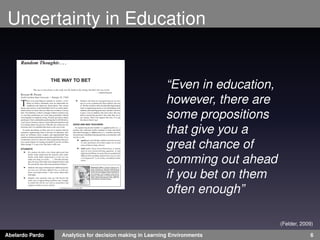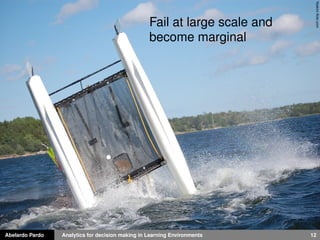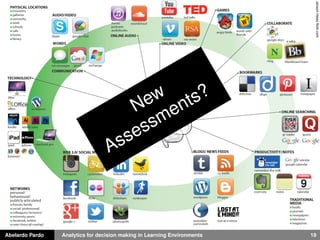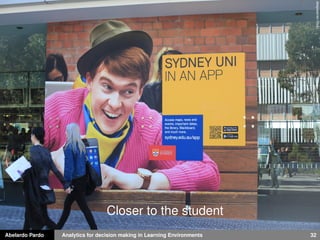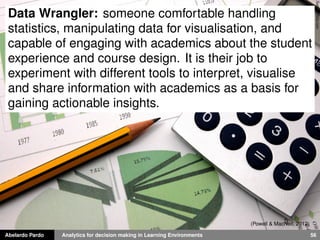Ad
Analytics for decision making in Learning Environments
- 1. Kris Krüg Flickr Analytics for decision making in Learning Environments Dr Abelardo Pardo (@abelardopardo) The University of Sydney slideshare.net/abelardo_pardo IARU EdTech Horizons Workshop Singapore, 14 November 2014
- 2. Abelardo Pardo Analytics for decision making in Learning Environments 2 Tristan Martin flickr.com Learning Analytics Collecting Observations Analysis and Visualization Interventions Institutional Adoption
- 3. Abelardo Pardo Analytics for decision making in Learning Environments 3 Tristan Martin flickr.com Learning Analytics
- 4. NY Times 24/11/12 Abelardo Pardo Analytics for decision making in Learning Environments 4
- 5. Abelardo Pardo Analytics for decision making in Learning Environments 5 jbgeronimi flickr.com Learning is complex and opaque
- 6. Uncertainty in Education “Even in education, however, there are some propositions that give you a great chance of comming out ahead if you bet on them often enough” (Felder, 2009) Abelardo Pardo Analytics for decision making in Learning Environments 6
- 7. Learning Analytics Measurement, collection, analysis and reporting of data about learners and their contexts, for purposes of understanding and optimizing learning and the environments in which it occurs. (SoLAR, Society for Learning Analytics Research) Abelardo Pardo Analytics for decision making in Learning Environments 7
- 8. Abelardo Pardo Analytics for decision making in Learning Environments 8 http://www.learninganalytics.net/?p=131 (last visited Sep 2013) (Siemens & Long, 2011)
- 9. www.solaresearch.org Abelardo Pardo Analytics for decision making in Learning Environments 9
- 10. L Jubar flickr.com Fork in the road: uptake? Abelardo Pardo Analytics for decision making in Learning Environments 10
- 11. Derable flickr.com High impact area: evolution, revolution, tangible improvements. Abelardo Pardo Analytics for decision making in Learning Environments 11
- 12. Yoakim flickr.com Fail at large scale and become marginal Abelardo Pardo Analytics for decision making in Learning Environments 12
- 13. Business Week May 01, 2014 400 data points per student Teacher in-class recordings Abelardo Pardo Analytics for decision making in Learning Environments 13
- 14. Where should I focus? Abelardo Pardo Analytics for decision making in Learning Environments 14 visible-learning.org/hattie-ranking-influences-effect-sizes-learning-achievement/hattie-ranking-teaching-effects (Last Accessed Nov. 2014)
- 15. Mary Witzig flickr.com Personalized Learning in a Digital Environment Abelardo Pardo Analytics for decision making in Learning Environments 15
- 16. Hiking Artist Learning Technology fails: hinders, prevents, complicates ... Abelardo Pardo Analytics for decision making in Learning Environments 16
- 17. Anthony flickr.com Tech affordances must have strong, realistic pedagogical foundations Abelardo Pardo Analytics for decision making in Learning Environments 17
- 18. VanessaO flickr.com “Historically, humanity has made sense of the world through discourse, dialogue, artifacts, myth, story, and metaphor. While those sensemaking approaches won’t disappear, they will be augmented by data and analytics.” George Siemens, www.elearnspace.org/blog/2014/04/11/open-learning-analytics/ Abelardo Pardo Analytics for decision making in Learning Environments 18
- 19. Janson Hews flickr.com New Assessments? Abelardo Pardo Analytics for decision making in Learning Environments 19
- 20. Ashley Fisher flickr.com 21st century skills Critical thinking Team work skills Communication skills Information literacy Creativity and Innovation Abelardo Pardo Analytics for decision making in Learning Environments 20
- 21. Discourse Analysis (De Liddo et al., 2011) Abelardo Pardo Analytics for decision making in Learning Environments 21
- 22. Paul Mayne flickr.com Learning Dispositions: Tendency to behave in certain way when learning. (Buckingham Sum, Deaking Crick, 2012) Abelardo Pardo Analytics for decision making in Learning Environments 22
- 23. Werner Kunz Flickr.com Predict The five steps of analytics Collect Report (Campbell, De Blois, Oblinger 2007, Academic Analytics, EDUCAUSE) Act Refine Abelardo Pardo Analytics for decision making in Learning Environments 23
- 24. Tristan Martin flickr.com Learning Analytics Collecting Observations Abelardo Pardo Analytics for decision making in Learning Environments 24
- 25. Example: Moodle Log • Course name • Date and time • IP Address (geolocation) • User full nane • Action: discussion mark read, forum add discussion, forum add post, forum delete discussion, forum update post, notes view, resource view, etc. • Additional information (Pardo, 2014) Abelardo Pardo Analytics for decision making in Learning Environments 25
- 26. Chef Cooke Flickr.com Observe while working on course activities Abelardo Pardo Analytics for decision making in Learning Environments 26
- 27. Abelardo Pardo Analytics for decision making in Learning Environments 27
- 28. Track Abelardo Pardo Analytics for decision making in Learning Environments 28
- 29. Track Track Abelardo Pardo Analytics for decision making in Learning Environments 29
- 30. com flickr.Davies Kevin A clearly identified environment within your computer Abelardo Pardo Analytics for decision making in Learning Environments 30 (Pardo & Delgado Kloos, 2011)
- 31. Instrumentation Personal Computer Virtual Computer Computer Tool 1 Computer Tool 2 Computer Tool 3 Computer Tool 4 Authenticated Computer Tool Computer Tool Computer Tool Computer Tool Computer Tool Student Instructor Act Infer Report Event Dataset Personal Data Encoding Abelardo Pardo Analytics for decision making in Learning Environments 31
- 32. deepwarren Flickr Closer to the student Abelardo Pardo Analytics for decision making in Learning Environments 32
- 33. From App to companion Finished focus group. Potential for student uptake. Abelardo Pardo Analytics for decision making in Learning Environments 33
- 34. puthoOr Photography flickr.com LMS interactions, quizzes, response times, sessions, hints requested, questionnaires, interviews, requests, demographics, high school grades, etc. (Bienkowski, M., Feng, M., & Means, B., 2012) Abelardo Pardo Analytics for decision making in Learning Environments 34
- 35. Naezmi flickr.com Learning Record Stores. Tin Can API Abelardo Pardo Analytics for decision making in Learning Environments 35
- 36. Space & Light Flickr • Data far away from instructor • Needs curation process Abelardo Pardo Analytics for decision making in Learning Environments 36
- 37. Tristan Martin flickr.com Learning Analytics Collecting Observations Analysis and Visualization Abelardo Pardo Analytics for decision making in Learning Environments 37
- 38. www.snappvis.org (Last accessed Nov. 2014) Bookmarklet in your browser Abelardo Pardo Analytics for decision making in Learning Environments 38
- 39. SAM (Govaerts et al., 2012) Abelardo Pardo Analytics for decision making in Learning Environments 39
- 40. Piazza Abelardo Pardo Analytics for decision making in Learning Environments 40
- 41. Student Engagement with Videos Flipped Classroom: Preparation activities Abelardo Pardo Analytics for decision making in Learning Environments 41
- 42. MCQ answers Abelardo Pardo Analytics for decision making in Learning Environments 42
- 43. Mr. Velocipede flickr.com Statistical analysis (small) Predictive algorithms Clustering Algorithms Relationship Mining Data Distillation Discovery with Models (Baker and Yacef, 2009) Abelardo Pardo Analytics for decision making in Learning Environments 43
- 44. (Macfadyen & Dawson, 2010) Abelardo Pardo Analytics for decision making in Learning Environments 44
- 45. Clustering, Classification, Rule inference (Romero, Ventura & García, 2008) Abelardo Pardo Analytics for decision making in Learning Environments 45
- 46. Tristan Martin flickr.com Learning Analytics Collecting Observations Analysis and Visualization Interventions Abelardo Pardo Analytics for decision making in Learning Environments 46
- 47. DullHunk flickr.com Reduce attrition. Phone 10 students this semester. Which students? When? Abelardo Pardo Analytics for decision making in Learning Environments 47
- 48. Abelardo Pardo Analytics for decision making in Learning Environments 48 neilspencerbruce flickr.com What aspects to personalize?
- 49. colecamp flickr.com A/B Testing: Space usage after change in course/curriculum Abelardo Pardo Analytics for decision making in Learning Environments 49
- 50. Abelardo Pardo Analytics for decision making in Learning Environments 50
- 51. Design Principles for Interventions • Integrated with the activity. Connected with concepts and assessment. • Interventions must support learning, not become an additional burden. • Provide measures that are considered desirable and why. • Discuss the process with the students. (Wise, 2014) Abelardo Pardo Analytics for decision making in Learning Environments 51
- 52. Tristan Martin flickr.com Learning Analytics Collecting Observations Analysis and Visualization Interventions Institutional Adoption Abelardo Pardo Analytics for decision making in Learning Environments 52
- 53. Secretlondon123 flickr.com 1 Context 2 Questions 3 Data + algorithms 4 Level of intervention Abelardo Pardo Analytics for decision making in Learning Environments 53
- 54. measure Joe flickr.com 1 Context: Student retention 2 Questions: Why do they leave? Can it be avoided? 3 Data + algorithms: ? 4 Level of intervention: ? Abelardo Pardo Analytics for decision making in Learning Environments 54
- 55. Shaylor flickr.com 1 Context: Student success 2 Questions: How did they learn? 3 Data + algorithms: ? 4 Level of intervention: ? Abelardo Pardo Analytics for decision making in Learning Environments 55
- 56. Salfalko flickr.com Data Wrangler: someone comfortable handling statistics, manipulating data for visualisation, and capable of engaging with academics about the student experience and course design. It is their job to experiment with different tools to interpret, visualise and share information with academics as a basis for gaining actionable insights. (Powell & MacNeil, 2012) Abelardo Pardo Analytics for decision making in Learning Environments 56
- 57. Kris Krüg Flickr Analytics for decision making in Learning Environments Dr Abelardo Pardo (@abelardopardo) The University of Sydney slideshare.net/abelardo_pardo IARU EdTech Horizons Workshop Singapore, 14 November 2014
- 58. References Baker, R. S. J. D., and Yacef, K., 2009. The state of educational data mining in 2009: A review and future visions. Journal of Educational Data Mining, 1(1), 3–17. Bienkowski, M., Feng, M., & Means, B. (2012). Enhancing Teaching and Learning Through Educational Data Mining and Learning Analytics. US Department of Education. Liddo, A. De, Shum, S., Quinto, I. (2011) Discourse-centric learning analytics. In Proceedings of the International Conference on Learning Analytics and Knowledge. Felder, R. M. (2006). The Way to Bet. Chemical Engineering Education, 40(1), 38–39. Govaerts, S., Verbert, K., Duval, E., & Pardo, A. (2012). The Student Activity Meter for Awareness and Self-reflection. In ACM SIGCHI International Conference on Human Factors in Computing Systems (pp. 869–884). Macfadyen, L. P., & Dawson, S. (2010). Mining LMS data to develop an “early warning system” for educators: A proof of concept. Computers & Education, 54(2), 588–599 Pardo, A., Delgado Kloos, C., 2011, Stepping out of the box. Towards analytics outside the Learning Management System International Conference on Learning Analytics and Knowledge, pp, 163-167, ACM New York, USA Abelardo Pardo Analytics for decision making in Learning Environments 58
- 59. References II Powell, S., & MacNeil, S. (2012). Analytics Series Institutional Readiness for Analytics (Vol. 1, pp. 1–11). JISC Center for Educational Technology & Interoperability Standards, Analytics Series, 1(8). Shum, S. B., and Crick, R. D. (2012) Learning Dispositions and Transferable Competencies: Pedagogy, Modelling and Learning Analytics. In S. Buckingham Shum, D. Gaševi´c, and R. Ferguson (Eds.), International Conference on Learning Analytics and Knowledge (pp. 92–101). ACM Press. Siemens, G., & Long, P. (2011). Penetrating the Fog: Analytics in Learning and Education. Educause Review, 48(5), Wise, A., 2014 Designing Pedagogical Interventions to Support Student Use of Learning Analytics. In A. Pardo & S. D. Teasley (Eds.), Proceedings of the International Conference on Learning Analytics and Knowledge. ACM Press. Abelardo Pardo Analytics for decision making in Learning Environments 59






